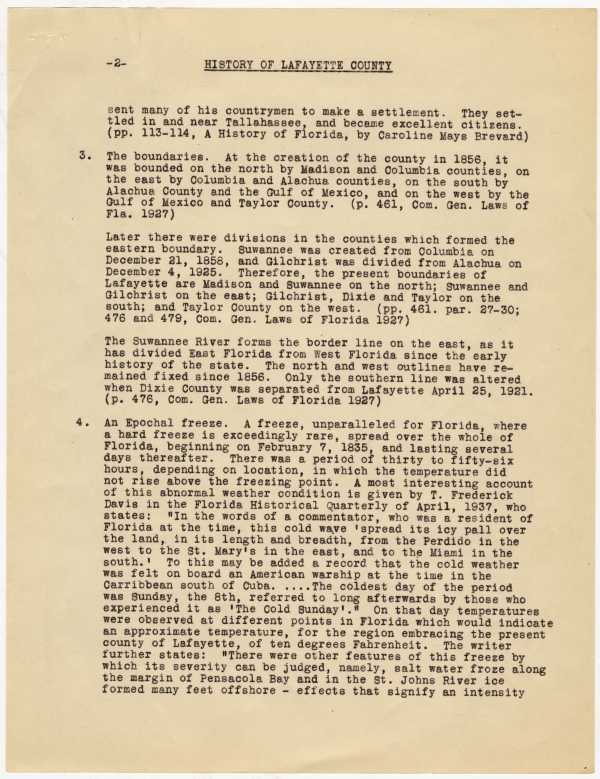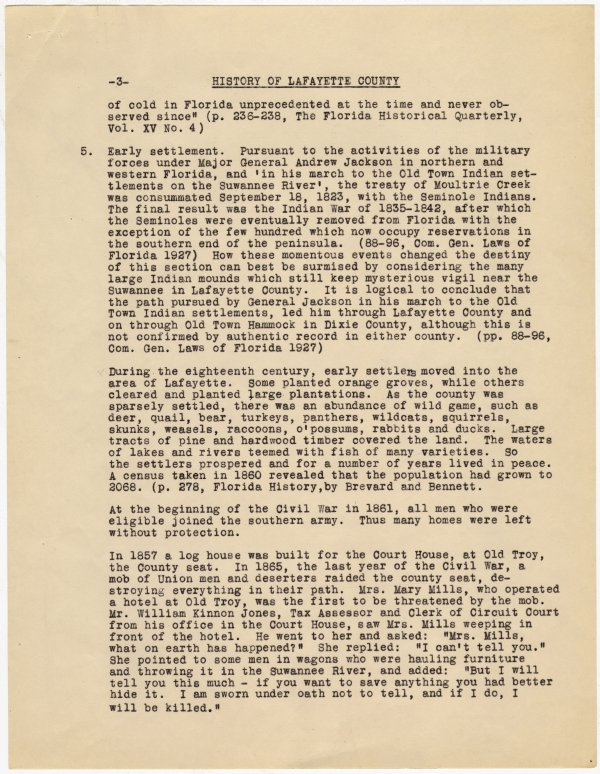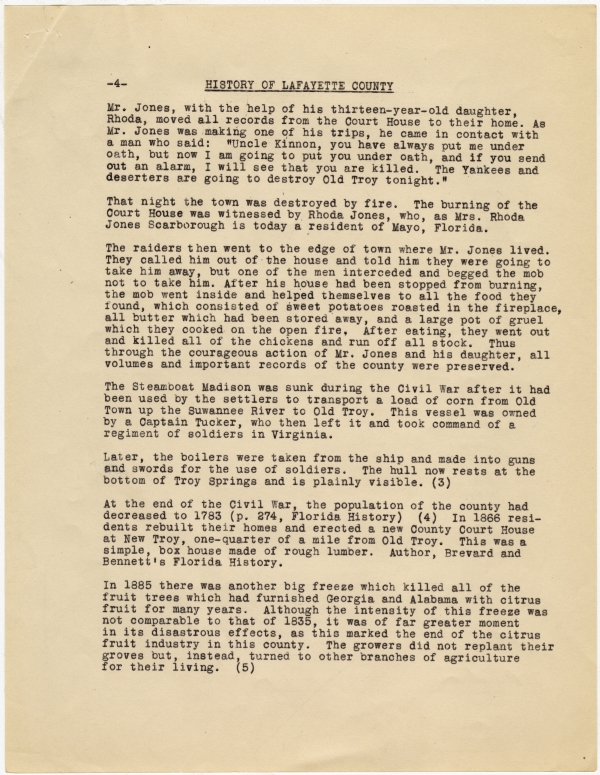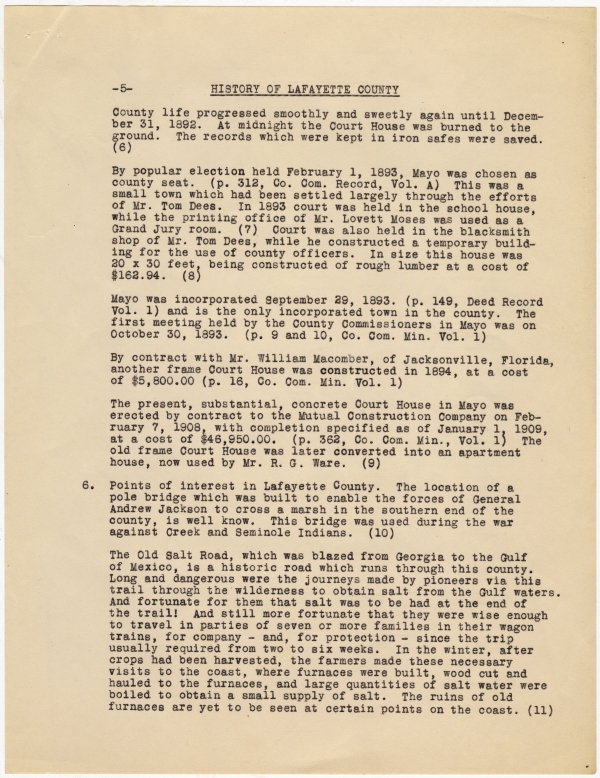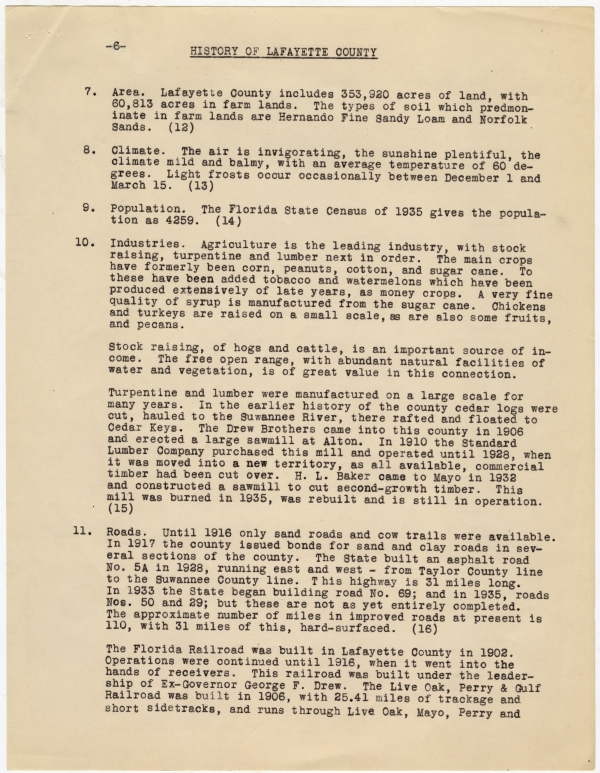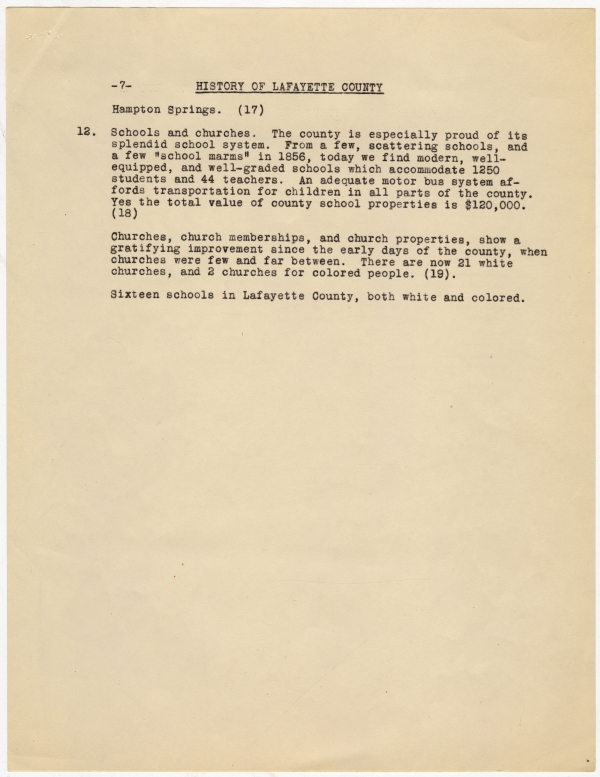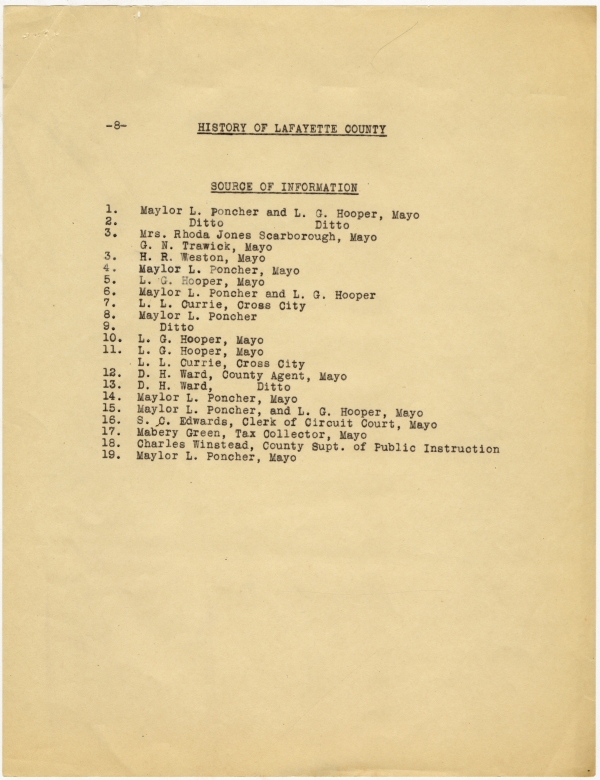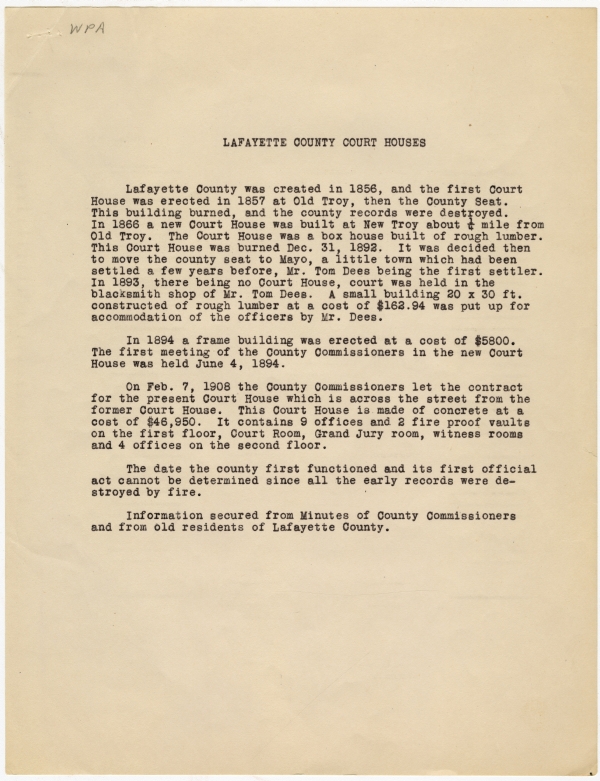Florida Memory is administered by the Florida Department of State, Division of Library and Information Services, Bureau of Archives and Records Management. The digitized records on Florida Memory come from the collections of the State Archives of Florida and the special collections of the State Library of Florida.

State Archives of Florida
- ArchivesFlorida.com
- State Archives Online Catalog
- ArchivesFlorida.com
- ArchivesFlorida.com
State Library of Florida
Related Sites
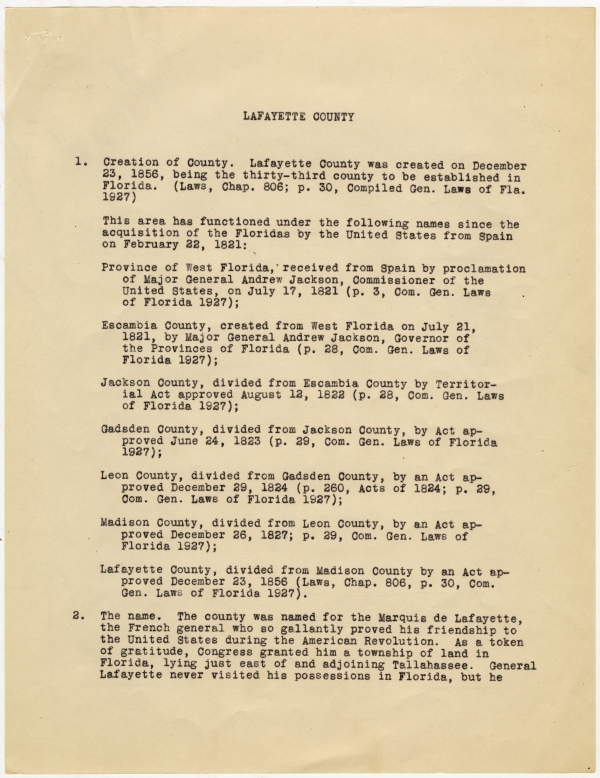
Description of previous item
Description of next item

Source
Description
Date
Format
Coverage
Personal Subjects
Subjects
Geographic Term
Note to Researchers:
Though the WPA field workers included extensive citations for the factual information contained in these county histories, it should be noted that these historical narratives were produced in the 1930s by federal government employees, and might reflect the inherent social biases of the era.
LAFAYETTE COUNTY
1. Creation of County. Lafayette County was created on December 23, 1856, being the thirty-third county to be established in Florida. (Laws, Chap. 806; p. 30, Compiled Gen. Laws of Fla. 1927)
This area has functioned under the following names since the acquisition of the Floridas by the United States from Spain on February 22, 1821:
Province of West Florida, received from Spain by proclamation of Major General Andrew Jackson, Commissioner of the United States, on July 17, 1821 (p. 3, Com. Gen. Laws of Florida 1927);
Escambia County, created from West Florida on July 21, 1821, by Major General Andrew Jackson, Governor of the Provinces of Florida (p. 28, Com. Gen. Laws of Florida 1927);
Jackson County, divided from Escambia County by Territorial Act approved August 12, 1822 (p. 28, Com. Gen. Laws of Florida 1927);
Gadsden County, divided from Jackson County, by Act approved June 24, 1823 (p. 29, Com. Gen. Laws of Florida 1927);
Leon County, divided from Gadsden County, by an Act approved December 29, 1824 (p. 260, Acts of 1824; p. 29, Com. Gen. Laws of Florida 1927);
Madison County, divided from Leon County, by an Act approved December 26, 1827; p. 29, Com. Gen. Laws of Florida 1927);
Lafayette County, divided from Madison County by an Act approved December 23, 1856 (Laws, Chap. 806, p. 30, Com. Gen. Laws of Florida 1927).
2. The name. The county was named for the Marquis de Lafayette, the French general who so gallantly proved his friendship to the United States during the American Revolution. As a token of gratitude, Congress granted him a township of land in Florida, lying just east of and adjoining Tallahassee. General Lafayette never visited his possessions in Florida, but he
Title
Subject
Description
Creator
Source
Date
Format
Language
Type
Identifier
Coverage
Thumbnail
Geographic Term
Display Date
ImageID
Subject - Person
Transcript
LAFAYETTE COUNTY
1. Creation of County. Lafayette County was created on December 23, 1856, being the thirty-third county to be established in Florida. (Laws, Chap. 806; p. 30, Compiled Gen. Laws of Fla. 1927)
This area has functioned under the following names since the acquisition of the Floridas by the United States from Spain on February 22, 1821:
Province of West Florida, received from Spain by proclamation of Major General Andrew Jackson, Commissioner of the United States, on July 17, 1821 (p. 3, Com. Gen. Laws of Florida 1927);
Escambia County, created from West Florida on July 21, 1821, by Major General Andrew Jackson, Governor of the Provinces of Florida (p. 28, Com. Gen. Laws of Florida 1927);
Jackson County, divided from Escambia County by Territorial Act approved August 12, 1822 (p. 28, Com. Gen. Laws of Florida 1927);
Gadsden County, divided from Jackson County, by Act approved June 24, 1823 (p. 29, Com. Gen. Laws of Florida 1927);
Leon County, divided from Gadsden County, by an Act approved December 29, 1824 (p. 260, Acts of 1824; p. 29, Com. Gen. Laws of Florida 1927);
Madison County, divided from Leon County, by an Act approved December 26, 1827; p. 29, Com. Gen. Laws of Florida 1927);
Lafayette County, divided from Madison County by an Act approved December 23, 1856 (Laws, Chap. 806, p. 30, Com. Gen. Laws of Florida 1927).
2. The name. The county was named for the Marquis de Lafayette, the French general who so gallantly proved his friendship to the United States during the American Revolution. As a token of gratitude, Congress granted him a township of land in Florida, lying just east of and adjoining Tallahassee. General Lafayette never visited his possessions in Florida, but he
-2-
HISTORY OF LAFAYETTE COUNTY
sent many of his countrymen to make a settlement. They settled in and near Tallahassee, and became excellent citizens. (pp. 113-114, A History of Florida, by Caroline Mays Brevard)
3. The boundaries. At the creation of the county in 1856, it was bounded on the north by Madison and Columbia counties, on the east by Columbia and Alachua counties, on the south by Alachua County and the Gulf of Mexico, and on the west by the Gulf of Mexico and Taylor County. (p. 461, Com. Gen. Laws of Fla. 1927)
Later there were divisions in the counties which formed the eastern boundary. Suwannee was created from Columbia on December 21, 1858, and Gilchrist was divided from Alachua on December 4, 1925. Therefore, the present boundaries of Lafayette are Madison and Suwannee on the north; Suwannee and Gilchrist on the east; Gilchrist, Dixie and Taylor on the south; and Taylor County on the west. (pp. 461. par. 27-30; 476 and 479, Com. Gen. Laws of Florida 1927)
The Suwannee River forms the border line on the east, as it has divided East Florida from West Florida since the early history of the state. The north and west outlines have remained fixed since 1856. Only the southern line was altered when Dixie County was separated from Lafayette April 25, 1921. (p. 476, Com. Gen. Laws of Florida 1927)
4. An Epochal freeze. A freeze, unparalleled for Florida, where a hard freeze is exceedingly rare, spread over the whole of Florida, beginning on February 7, 1835, and lasting several days thereafter. There was a period of thirty to fifty-six hours, depending on location, in which the temperature did not rise above the freezing point. A most interesting account of this abnormal weather condition is given by T. Frederick Davis in the Florida Historical Quarterly of April, 1937, who states: "In the words of a commentator, who was a resident of Florida at the time, this cold wave 'spread its icy pall over the land, in its length and breadth, from the Perdido in the west to the St. Mary's in the east, and to the Miami in the south.' To this may be added a record that the cold weather was felt on board an American warship at the time in the [Caribbean] south of Cuba.....The coldest day of the period was Sunday, the 8th, referred to long afterwards by those who experienced it as 'The Cold Sunday'." On that day temperatures were observed at different points in Florida which would indicate an approximate temperature, for the region embracing the present county of Lafayette, of ten degrees Fahrenheit. The writer further states: "There were other features of this freeze by which its severity can be judged, namely, salt water froze along the margin of Pensacola Bay and in the St. Johns River ice formed many feet offshore - effects that signify an intensity
-3-
HISTORY OF LAFAYETTE COUNTY
of cold in Florida unprecedented at the time and never observed since" (p. 236-238, The Florida Historical Quarterly, Vol. XV No. 4)
5. Early settlement. Pursuant to the activities of the military forces under Major General Andrew Jackson in northern and western Florida, and 'in his march to the Old Town Indian settlements on the Suwannee River', the treaty of Moultrie Creek was consummated September 18, 1823, with the Seminole Indians. The final result was the Indian War of 1835-1842, after which the Seminoles were eventually removed from Florida with the exception of the few hundred which now occupy reservations in the southern end of the peninsula. (88-96, Com. Gen. Laws of Florida 1927) How these momentous events changed the destiny of this section can best be surmised by considering the many large Indian mounds which still keep mysterious vigil near the Suwannee in Lafayette County. It is logical to conclude that the path pursued by General Jackson in his march to the Old Town Indian settlements, led him through Lafayette County and on through Old Town Hammock in Dixie County, although this is not confirmed by authentic record in either county. (pp. 88-96, Com. Gen. Laws of Florida 1927)
During the eighteenth century, early settlers moved into the area of Lafayette. Some planted orange groves, while others cleared and planted large plantations. As the county was sparsely settled, there was an abundance of wild game, such as deer, quail, bear, turkeys, panthers, wildcats, squirrels, skunks, weasels, raccoons, o'possums [sic], rabbits and ducks. Large tracts of pine and hardwood timber covered the land. The waters of lakes and rivers teemed with fish of many varieties. So the settlers prospered and for a number of years lived in peace. A census taken in 1860 revealed that the population had grown to 2068. (p. 278, Florida History, by Brevard and Bennett.[)]
At the beginning of the Civil War in 1861, all men who were eligible joined the southern army. Thus many homes were left without protection.
In 1857 a log house was built for the Court House, at Old Troy, the County seat. In 1865, the last year of the Civil War, a mob of Union men and deserters raided the county seat, destroying everything in their path. Mrs. Mary Mills, who operated a hotel at Old Troy, was the first to be threatened by the mob. Mr. William Kinnon Jones, Tax Assessor and Clerk of Circuit Court from his office in the Court House, saw Mrs. Mills weeping in front of the hotel. He went to her and asked: "Mrs. Mills, what on earth has happened?" She replied: "I can't tell you." She pointed to some men in wagons who were hauling furniture and throwing it in the Suwannee River, and added: "But I will tell you this much - if you want to save anything you had better hide it. I am sworn under oath not to tell, and if I do, I will be killed."
-4-
HISTORY OF LAFAYETTE COUNTY
Mr. Jones, with the help of his thirteen-year-old daughter, Rhoda, moved all records from the Court House to their home. As Mr. Jones was making one of his trips, he came in contact with a man who said: "Uncle Kinnon, you have always put me under oath, but now I am going to put you under oath, and if you send out an alarm, I will see that you are killed. The Yankees and deserters are going to destroy Old Troy tonight."
That night the town was destroyed by fire. The burning of the Court House was witnessed by Rhoda Jones, who, as Mrs. Rhoda Jones Scarborough is today a resident of Mayo, Florida.
The raiders then went to the edge of town where Mr. Jones lived. They called him out of the house and told him they were going to take him away, but one of the men interceded and begged the mob not to take him. After his house had been stopped from burning, the mob went inside and helped themselves to all the food they found, which consisted of sweet potatoes roasted in the fireplace, all butter which had been stored away, and a large pot of gruel which they cooked on the open fire. After eating, they went out and killed all of the chickens and run off all stock. Thus through the courageous action of Mr. Jones and his daughter, all volumes and important records of the county were preserved.
The Steamboat Madison was sunk during the Civil War after it had been used by the settlers to transport a load of corn from Old Town up the Suwannee River to Old Troy. This vessel was owned by a Captain Tucker, who then left it and took command of a regiment of soldiers in Virginia.
Later, the boilers were taken from the ship and made into guns and swords for the use of soldiers. The hull now rests at the bottom of Troy Springs and is plainly visible. (3)
At the end of the Civil War, the population of the county had decreased to 1783 (p. 274, Florida History) (4) In 1866 residents rebuilt their homes and erected a new County Court House at New Troy, one-quarter of a mile from Old Troy. This was a simple, box house made of rough lumber. Author, Brevard and Bennett's Florida History.
In 1885 there was another big freeze which killed all of the fruit trees which had furnished Georgia and Alabama with citrus fruit for many years. Although the intensity of this freeze was not comparable to that of 1835, it was of far greater moment in its disastrous effects, as this marked the end of the citrus fruit industry in this county. The growers did not replant their groves but, instead, turned to other branches of agriculture for their living. (5)
-5-
HISTORY OF LAFAYETTE COUNTY
County life progressed smoothly and sweetly again until December 31, 1892. At midnight the Court House was burned to the ground. The records which were kept in iron safes were saved. (6)
By popular election held February 1, 1893, Mayo was chosen as county seat. (p. 312, Co. Com. Record, Vol. A) This was a small town which had been settled largely through the efforts of Mr. Tom Dees. In 1893 court was held in the school house, while the printing office of Mr. Lovett Moses was used as a Grand Jury room. (7) Court was also held in the blacksmith shop of Mr. Tom Dees, while he constructed a temporary building for the use of county officers. In size this house was 20 x 30 feet, being constructed of rough lumber at a cost of $162.94. (8)
Mayo was incorporated September 29, 1893. (p. 149, Deed Record Vol. 1) and is the only incorporated town in the county. The first meeting held by the County Commissioners in Mayo was on October 30, 1893. (p. 9 and 10, Co. Com. Min. Vol. 1)
By contract with Mr. William Macomber, of Jacksonville, Florida, another frame Court House was constructed in 1894, at a cost of $5,800.00 (p. 16, Co. Com. Min. Vol. 1)
The present, substantial, concrete Court House in Mayo was erected by contract to the Mutual Construction Company on February 7, 1908, with completion specified as of January 1, 1909, at a cost of $46,950.00. (p. 362, Co. Com. Min., Vol. 1) The old frame Court House was later converted into an apartment house, now used by Mr. R. G. Ware. (9)
6. Points of interest in Lafayette County. The location of a pole bridge which was built to enable the forces of General Andrew Jackson to cross a marsh in the southern end of the county, is well know[n]. This bridge was used during the war against Creek and Seminole Indians. (10)
The Old Salt Road, which was blazed from Georgia to the Gulf of Mexico, is a historic road which runs through this county. Long and dangerous were the journeys made by pioneers via this trail through the wilderness to obtain salt from the Gulf waters. And fortunate for them that salt was to be had at the end of the trail! And still more fortunate that they were wise enough to travel in parties of seven or more families in their wagon trains, for company - and, for protection - since the trip usually required from two to six weeks. In the winter, after crops had been harvested, the farmers made these necessary visits to the coast, where furnaces were built, wood cut and hauled to the furnaces, and large quantities of salt water were boiled to obtain a small supply of salt. The ruins of old furnaces are yet to be seen at certain points on the coast. (11)
-6-
HISTORY OF LAFAYETTE COUNTY
7. Area. Lafayette County includes 353,920 acres of land, with 60, 813 acres in farm lands. The types of soil which predominate in farm lands are Hernando Fine Sandy Loam and Norfolk Sands. (12)
8. Climate. The air is invigorating, the sunshine plentiful, the climate mild and balmy, with an average temperature of 60 degrees. Light frosts occur occasionally between December 1 and March 15. (13)
9. Population. The Florida State Census of 1935 gives the population as 4259. (14)
10. Industries. Agriculture is the leading industry, with stock raising, turpentine and lumber next in order. The main crops have formerly been corn, peanuts, cotton, and sugar cane. To these have been added tobacco and watermelons which have been produced extensively of late years, as money crops. A very fine quality of syrup is manufactured from the sugar cane. Chickens and turkeys are raised on a small scale, as are also some fruits, and pecans.
Stock raising, of hogs and cattle, is an important source of income. The free open range, with abundant natural facilities of water and vegetation, is of great value in this connection.
Turpentine and lumber were manufactured on a large scale for many years. In the earlier history of the county cedar logs were cut, hauled to the Suwannee River, there rafted and floated to Cedar Keys. The Drew Brothers came into this county in 1906 and erected a large sawmill at Alton. In 1910 the Standard Lumber Company purchased this mill and operated until 1928, when it was moved into a new territory, as all available, commercial timber had been cut over. H. L. Baker came to Mayo in 1932 and constructed a sawmill to cut second-growth timber. This mill was burned in 1935, was rebuilt and is still in operation. (15)
11. Roads. Until 1916 only sand roads and cow trails were available. In 1917 the county issued bonds for sand and clay roads in several sections of the county. The State built an asphalt road No. 5A in 1928, running east and west - from Taylor County line to the Suwannee County line. This highway is 31 miles long. In 1933 the State began building road No. 69; and in 1935, roads Nos. 50 and 29; but these are not as yet entirely completed. The approximate number of miles in improved roads at present is 110, with 31 miles of this, hard-surfaced. (16)
The Florida Railroad was built in Lafayette County in 1902. Operations were continued until 1916, when it went into the hands of receivers. This railroad was built under the leadership of Ex-Governor George F. Drew. The Live Oak, Perry & Gulf Railroad was built in 1906, 25.41 miles of trackage and short sidetracks, and runs through Live Oak, Mayo, Perry and
-7-
HISTORY OF LAFAYETTE COUNTY
Hampton Springs. (17)
12. Schools and churches. The county is especially proud of its splendid school system. From a few, scattering schools, and a few "school marms" in 1856, today we find modern, well-equipped, and well-graded schools which accommodate 1250 students and 44 teachers. An adequate motor bus system affords transportation for children in all parts of the county. Yes the total value of county school properties is $120,000. (18)
Churches, church memberships, and church properties, show a gratifying improvement since the early days of the county, when churches were few and far between. There are now 21 white churches, and 2 churches for colored people. (19).
Sixteen schools in Lafayette County, both white and colored.
-8-
HISTORY OF LAFAYETTE COUNTY
SOURCE OF INFORMATION
1. Maylor L. Poncher and L. G. Hooper, Mayo
2. Ditto Ditto
3. Mrs. Rhoda Jones Scarborough, Mayo
G. N. Trawick, Mayo
3. H. R. Weston, Mayo
4. Maylor L. Poncher, Mayo
5. L. G. Hooper, Mayo
6. Maylor L. Poncher and L. G. Hooper
7. L. L. Currie, Cross City
8. Maylor L. Poncher
9. Ditto
10. L. G. Hooper, Mayo
11. L. G. Hooper, Mayo
L. L. Currie, Cross City
12. D. H. Ward, County Agent, Mayo
13. D. H. Ward, Ditto
14. Maylor L. Poncher, Mayo
15. Maylor L. Poncher, and L. G. Hooper, Mayo
16. S. C. Edwards, Clerk of Circuit Court, Mayo
17. Mabery Green, Tax Collector, Mayo
18. Charles Winstead, County Supt. of Public Instruction
19. Maylor L. Poncher, Mayo
WPA
LAFAYETTE COUNTY COURT HOUSES
Lafayette County was created in 1856, and the first Court House was erected in 1857 at Old Troy, then the County Seat. This building burned, and the county records were destroyed. In 1866 a new Court House was built at New Troy about 1/4 mile from Old Troy. The Court House was a box house built of rough lumber. This Court House was burned Dec. 31, 1892. It was decided then to move the county seat to Mayo, a little town which had been settled a few years before, Mr. Tom Dees being the first settler. In 1893, there being no Court House, court was held in the blacksmith shop of Mr. Tom Dees. A small building 20 x 30 ft. constructed of rough lumber at a cost of $162.94 was put up for accommodation of the officers by Mr. Dees.
In 1894 a frame building was erected at a cost of $5800. The first meeting of the County Commissioners in the new Court House was held June 4, 1894.
On Feb. 7, 1908 the County Commissioners let the contract for the present Court House which is across the street from the former Court House. This Court House is made of concrete at a cost of $46,950. It contains 9 offices and 2 fire proof vaults on the first floor, Court Room, Grand Jury room, witness rooms and 4 offices on the second floor.
The date the county first functioned and its first official act cannot be determined since all the early records were destroyed by fire.
Information secured from Minutes of County Commissioners and from old residents of Lafayette County.
Chicago Manual of Style
Works Progress Administration, Historical Records Survey. History of Lafayette County. 1939 (circa). State Archives of Florida, Florida Memory. <https://www.floridamemory.com/items/show/321122>, accessed 18 December 2025.
MLA
Works Progress Administration, Historical Records Survey. History of Lafayette County. 1939 (circa). State Archives of Florida, Florida Memory. Accessed 18 Dec. 2025.<https://www.floridamemory.com/items/show/321122>
AP Style Photo Citation
(State Archives of Florida/Works Progress Administration)

 Listen: The Folk Program
Listen: The Folk Program